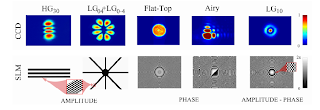African physicists build the first laser with a beam that can be controlled and shaped digitally
TECHNOLOGY REVIEW: Lasers are one of the emblematic technologies of the modern world. The chances are that most readers will be less than a metre away from a laser of some kind as they read this. Lasers fill our world.
In principle, they are simple devices. They consist of a couple of mirrors, a source of energy, usually light, and a lasing cavity in which the light can bounce back and forth.
The trick is to fill the lasing cavity with a material known as a gain medium which amplifies at a specific frequency when stimulated by light of another frequency. When this amplified light is directed out of the cavity, using a half-mirror, it forms a narrow beam of coherent light of a single specific frequency–a laser beam.
For many applications, the shape of this beam– the way the light intensity varies across the beam–is important.
But because these devices are essentially bolted on to the front of a laser, they all require expensive custom optics that have to be calibrated each time they are changed.
Today, however, Sandile Ngcobo at the University of KwaZulu–Natal in South Africa and few buddies, say they’ve worked out a way round this. And they've designed and built a device to test their idea.
The solution is simple. Instead of putting a spatial light modulator in front of the laser, they’ve built one in to the device, where it acts as the mirror at one end of the cavity. In this way, the spatial light modulator shapes the beam as it is being amplified.
Physics arXiv: The digital laser

Comments